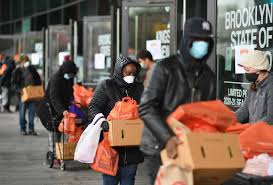Why isn’t the stock market much lower?
This question is occurring to plenty of observers right now, given the apparent contrast between economic realities and equity performance.
A pandemic-driven economic catastrophe of unprecedented speed has cost more than 26 million jobs, which to many seems unreflected in an S&P 500 index that’s up 29% from its low a month ago, down a mere 16% from a record high and resting near levels from late summer 2019 – a time when we were at full employment and record corporate profitability.
Even some on Wall Street are remarking on this perceived Wall Street-Main Street disconnect.
Cantor Fitzgerald strategist Peter Cecchini last week argued, “The equity market just isn’t getting the joke. Three factors make this rally appear somewhat ridiculous because the likely extent of the slowdown will be severe relative to historical experience for three reasons: 1) a pandemic whose duration is unknowable, 2) an oil shock whose impacts on earnings will be deflationary, and 3) an already fragile economy as indicated by an inverted yield curve and already contracting loan volumes.”
Credit Suisse’s Jonathan Golub notes the S&P 500 has been at the current 2800 level a couple of times in recent years, comparing the fundamental context for each visit. When the S&P traded here in both January 2018 and March 2019, forecast earnings over the next year were appreciably higher (meaning stocks now look more expensive) and credit spreads are much wider now (suggesting a riskier environment).
Only when comparing valuations on the profit projections two years out does today’s market look roughly in line with the prior stops at 2800. And it’s probably fair to assume that today’s consensus forecast calling for 2021 earnings growth well above 2019 levels is unadjusted for the full realities of the economic shock underway.
Certainly, the trillions in Federal reserve asset buying has helped enable the rally in risk assets that has lifted equities off their lows and bolstered valuations.
Market internals tell the true story
Yet the way the S&P has returned to 2800 doesn’t truly suggest that the market has rushed to anticipate a roaring economic revival.
If stocks were handicapping such a quick resurgence in the economy, one would expect “early cycle” groups such as autos, banks, consumer durable goods and retail to lead the market. This is the opposite of what’s going on.
Binky Chadha of Deutsche Bank notes that the firm’s early-cycle long-short basket of stocks “after falling massively during the sell-off has continued to fall during the rally.”
Similarly, the Direxion MSCI Cyclicals Over Defensives ETF, a small fund that goes long economically sensitive stocks and short non-cyclical names, has had a fairly feeble bounce after a 38-percent collapse, badly trailing the S&P on the rebound.

Big, steady secular-growth stocks in technology, healthcare and consumer staples are holding things together at the big-cap index level against a steady undertow from shares of cyclical businesses with flagging demand and shakier balance sheets.
This is visible in the gulf between the performance of classic “recession-recovery” plays such as General Motors, flooring-products maker Mohawk Industries and consumer lender Capital One Financial and secular-growth or counter-cyclical names like Amazon, Abbot Laboratories and Campbell Soup.

Amazon exemplifies another dominant trend, the premium being placed by investors on the acclaimed winners of an even more winner-take-all economy that might follow this downturn. Amazon’s $1.2 trillion market value, in fact, now accounts for more than 40% of the entire value of the S&P 500 consumer-discretionary sector.
Of course, just because the market is leaning on sturdy growth businesses rather than outright positioning for a better economy doesn’t mean this theme can carry the market indefinitely higher from here.
Market stalling
The S&P, in fact, has stalled over the past two weeks, chopping sideways just below the rebound-rally highs, as some growth stocks take a breather and short-term overbought conditions are worked off.
It would not be surprising for the indexes to continue digesting the move, assimilating the rush of corporate earnings in coming weeks, with some observers looking for a potential pullback of a few percent from here simply as a matter of technical market positioning.
And at some point, the extreme reliance on the mega-cap growth leaders can go too far. The five largest stocks already make up more than 20% of the S&P, pushing record concentration at the top.
Flows into the ETFS that track the Nasdaq 100, technology, healthcare and utilities have reached extremes, a sign they are getting a bit overheated and are prone to backing off.
At the same time, the market will almost certainly start to anticipate the trough in economic activity well before it seems obvious on Main Street that things are getting better. That would be visible in a rotation out of the crowded stable-growth names and into those distressed, struggling cyclical consumer, financial and industrial groups.
Historically, the stock market has some of its best returns when conditions are shifting from awful to less bad. The recent rally in energy stocks in the face of record-low washout prices in crude oil is an illustration of that.
As Strategas Group technical strategist Chris Verrone notes, “It’s difficult to get worse than worst ever,” and many gauges are, like oil prices, indeed at or near their worst readings on record: unemployment claims, Europe manufacturing indexes, Citigroup Economic Surprise Index.
Things might soon line up for investors to start making a more aggressive bet the worst will pass before long and the real economy can start the healing process. And perhaps that bet will prove premature for a while once its laid.
But that doesn’t mean that right now Wall Street has already given the economy credit for recovering from an ordeal whose pain and duration are not yet known.

